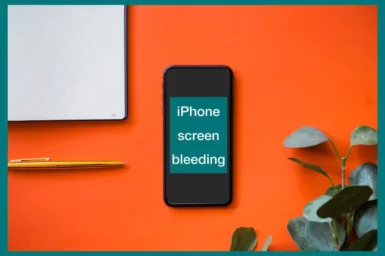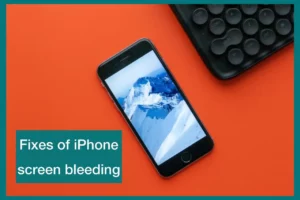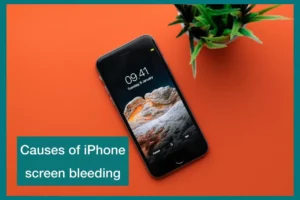Have you ever been confused by odd light patches around the edges of your iPhone’s screen? It’s not just you. Many people have been confused by the occurrence of iPhone screen bleeding.
In this article, we’ll delve into the details of screen bleeding, examine its causes, and offer workable solutions to help you understand and fix this problem with your cherished device.
What Does it Mean When an iPhone Screen Bleeds?
When an iPhone screen “bleeds,” it means that light seeps in from the display’s borders, producing uneven illumination and frequently appearing as erratic patches or streaks of light.
This problem generally appears towards the screen’s edges, giving the appearance that light is “bleeding” into the viewing area.
Users who experience screen bleeding on their iPhones must understand the sources and effects of the issue. We’ll examine the typical causes of screen bleeding in more detail in the next headings, as well as potential fixes.
Causes of iPhone Screen Bleeding
Understanding these potential causes of screen bleeding is important to correctly troubleshoot and fix the problem.
1. Manufacturing Defects
Screen bleeding on iPhones can be attributed to several things, including manufacturing errors.
Gaps that permit light to pass through can develop during the manufacturing process as a result of improper component placement or inadequate bonding between the layers of the screen. These flaws aren’t always immediately obvious, but they sometimes do.
2. Physical Damage
The iPhone’s screen can bleed if it suffers physical damage from drops or impacts. These occurrences can move or harm the display assembly’s delicate components, resulting in light leakage.
The problem might be made worse by even little cracks or pressure on the screen.
3. Poor-Quality Repairs
Screen bleeding can occur if an iPhone is repaired or has its screen replaced by an unqualified technician or with poor replacement parts. Light leakage can be brought on by subpar parts or incorrect installation, compromising the integrity of the display.
4. Temperature and Environmental Factors
Extreme temperature changes or moisture exposure can impact the glues and materials used in the iPhone display assembly. Screen bleeding can occur due to the components deteriorating or losing structural integrity over time.
5. Software Problems
Although less frequent, software errors can also cause screen bleeding. Certain operating system or firmware problems can lead to abnormalities in screen lighting, giving the impression that there is bleeding when there is a software issue.
Can you Fix the Bleeding Screen of the iPhone?
Yes, It is possible to repair an iPhone with a bleeding screen. Screen bleeding issues can be handled using techniques and solutions, regardless of whether manufacturing flaws, physical damage, or other circumstances bring on the problem.
The problem can frequently be resolved, and the iPhone’s display can be returned to its original functionality by consulting a specialist or doing the necessary repairs.
Before trying any repairs, it is important to identify the underlying source of the issue because the effectiveness of the repair depends on the nature and degree of the screen bleeding.
How to Fix iPhone Screen Bleeding?
Remember that the best way to fix iPhone screen bleeding depends on the nature and extent of the problem. If you’re unclear about the appropriate course of action, it is recommended that you talk with a specialist.
1. Professional Repair Services
The safest and most efficient way of fixing iPhone screen bleeding is frequently to seek the advice of a certified technician or an authorized Apple service facility.
Professionals can precisely identify the problem and make the required repairs, which can involve exchanging any damaged parts or the complete screen assembly.
2. Screen Replacement
Changing the screen may be the best option if the bleeding is serious or results from physical damage. This involves removing the broken screen and installing a new one to ensure optimal operation and visual quality.
3. Check for Loose Connections
If you are comfortable opening your iPhone and have the technical knowledge, you can look for loose connections inside the display assembly. Minor screen bleeding difficulties may occasionally be resolved by reseating or securing these connections.
4. Software Updates and Resets
Sometimes, software flaws or anomalies may be the cause of screen bleeding. These problems can be resolved by updating the iPhone’s operating system or doing a factory reset. However, this should only be used as a last option after eliminating hardware-related issues.
5. Avoiding Pressure and Temperature Extremes
Avoiding extreme pressure and temperature is important since it will help stop future damage. Avoid putting too much pressure on the screen and exposing your iPhone to hot or cold conditions.
These safety measures can assist in maintaining the integrity of the display assembly and stop screen bleeding issues in the future.
How Much Does It Cost to Fix a Bleeding iPhone Screen?
The price of repairing an iPhone screen that is bleeding might differ significantly depending on the brand of the phone, the extent of the bleeding, and where you get the repair done. Here are some broad price ranges.
1. Authorized Apple Service Centers
Choosing an authorized Apple service center will usually result in a greater cost for repairing or replacing the screen. Still, you can be sure that the parts are authentic Apple products and the technicians are knowledgeable.
Depending on your iPhone model and any further repairs required, prices can range from $129 to $329 or even more.
2. Third-Party Repair Shops
Third-party repair shops could have more affordable prices; however, prices might change based on your area and the shop’s reputation. The typical screen repair cost from a reliable third-party source is $50 to $200.
3. DIY Repair Kits
You can buy DIY repair kits online if you have the technical know-how and self-assurance to fix the screen. The tools required for the repair are usually included in these kits, along with replacement screens.
Prices might range from $20 to $100 or more depending on the type of the iPhone and the quality of the new parts.
Remember, Though DIY kits could seem cost-effective, remember that they come with dangers, and wrong installation could result in additional damage or void your iPhone’s warranty.
It’s best to thoroughly consider your alternatives and pick a repair approach that fits your needs in terms of money and level of comfort with DIY versus professional services.
In addition, for qualified devices, some repairs can be covered by AppleCare or other warranty courses, lowering the out-of-pocket expense.
Conclusion
In conclusion, iPhone screen bleeding is a frustrating problem for various reasons, ranging from physical damage to manufacturing flaws. It can be fixed using expert services, a new screen, or, in some situations, do-it-yourself methods. Prices can vary widely based on variables like the iPhone model and repair service.
In the end, the choice of repair technique should be based on the seriousness of the problem and personal preferences, keeping in mind how crucial it is to preserve device performance and quality.



